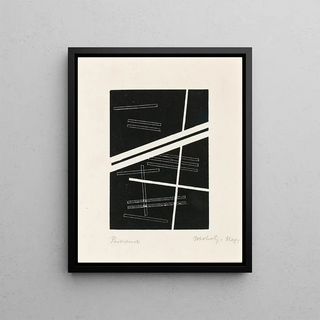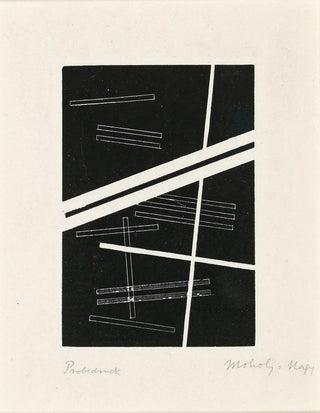Art print | Untitled Composition - László Moholy-Nagy


View from behind

Frame (optional)
Composition without title - László Moholy-Nagy – Captivating introduction
At the heart of the Bauhaus movement, László Moholy-Nagy masterfully fused art and technology with rare boldness. His iconic piece, "Composition without title," embodies this relentless pursuit of innovation and experimentation that defined the 20th century. This work, both abstract and dynamic, invites viewers to immerse themselves in a universe where shapes and colors meet in a harmonious dance. The art print of this piece allows for rediscovering Moholy-Nagy's avant-garde vision, while offering a window into an era where art aimed to be both accessible and deeply engaged.
Style and uniqueness of the work
"Composition without title" stands out through its daring use of color and form. The graphic elements, juxtaposed with surgical precision, create a visual tension that captivates the eye. The artist plays with contrasts, using vivid hues and geometric shapes to generate a sense of movement and energy. This non-figurative approach, characteristic of abstract art, prompts viewers to question the very nature of perception. Moholy-Nagy, as a pioneer, does not merely depict reality; he reinvents it, encouraging reflection on how art can transcend traditional boundaries. The richness of his work lies in its ability to evoke emotions while stimulating the intellect.
The artist and his influence
László Moholy-Nagy, born in Hungary in 1895, quickly established himself as a central figure of the Bauhaus, a movement that revolutionized art education and practice. His interdisciplinary approach, blending photography, design, and painting, opened new pathways for modern art. Moholy-Nagy knew how to build bridges between different forms of expression, influencing generations of artists and designers. His work on light, in particular, marked a turning point in visual representation, incorporating kinetic and interactive elements that still resonate today. By redefining the relationship between the artist and his work, he also contributed to the democratization of art, making it accessible to a broader audience.

Matte finish

View from behind

Frame (optional)
Composition without title - László Moholy-Nagy – Captivating introduction
At the heart of the Bauhaus movement, László Moholy-Nagy masterfully fused art and technology with rare boldness. His iconic piece, "Composition without title," embodies this relentless pursuit of innovation and experimentation that defined the 20th century. This work, both abstract and dynamic, invites viewers to immerse themselves in a universe where shapes and colors meet in a harmonious dance. The art print of this piece allows for rediscovering Moholy-Nagy's avant-garde vision, while offering a window into an era where art aimed to be both accessible and deeply engaged.
Style and uniqueness of the work
"Composition without title" stands out through its daring use of color and form. The graphic elements, juxtaposed with surgical precision, create a visual tension that captivates the eye. The artist plays with contrasts, using vivid hues and geometric shapes to generate a sense of movement and energy. This non-figurative approach, characteristic of abstract art, prompts viewers to question the very nature of perception. Moholy-Nagy, as a pioneer, does not merely depict reality; he reinvents it, encouraging reflection on how art can transcend traditional boundaries. The richness of his work lies in its ability to evoke emotions while stimulating the intellect.
The artist and his influence
László Moholy-Nagy, born in Hungary in 1895, quickly established himself as a central figure of the Bauhaus, a movement that revolutionized art education and practice. His interdisciplinary approach, blending photography, design, and painting, opened new pathways for modern art. Moholy-Nagy knew how to build bridges between different forms of expression, influencing generations of artists and designers. His work on light, in particular, marked a turning point in visual representation, incorporating kinetic and interactive elements that still resonate today. By redefining the relationship between the artist and his work, he also contributed to the democratization of art, making it accessible to a broader audience.






